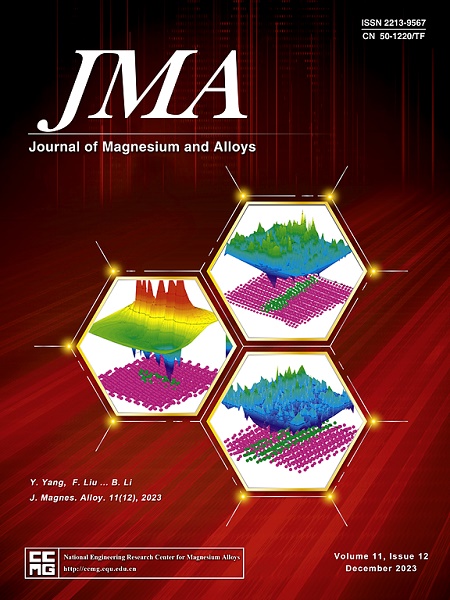A high-performance degradable Mg alloy suturing staple for single-arm oral stapling robot
IF 15.8
1区 材料科学
Q1 METALLURGY & METALLURGICAL ENGINEERING
引用次数: 0
Abstract
Minimally invasive surgery (MIS) robots, such as single-arm stapling robots, are key to oral and maxillofacial surgery because they overcome space constraints in the oral cavity and deep throat. However, biodegradable suture staples should be developed for the single-arm stapling robots to avoid a secondary operation. For this aim, a new type of Mg-3Zn-0.2Ca-2Ag biodegradable alloy wire was developed in this study applied as suture staples. Its tensile strength, yield strength, and elongation are 326.1 MPa, 314.5 MPa, and 19.6%, respectively. Especially, the alloy wire attains the highest yield strength value reported among all the biodegradable Mg wires, which is mainly attributed to fine grain strengthening and second phase strengthening such as Mg2Zn11 nano phase strengthening. Moreover, the corrosion rate of this alloy wire in simulated body fluid (SBF) reaches 26.8 mm/y, the highest value among all the biodegradable Mg alloy wires reported so far, which is mainly from the intensified galvanic corrosion between the Ag17Mg54 phase and the Mg matrix. In vitro studies demonstrate that the alloy wire exhibits good blood compatibility and low cytotoxicity. The cone beam computed tomography (CBCT) data shows that the suture staple made of the Mg alloy wire provides better mechanical support in the early postoperative period. From the single arm robot tests, it confirms that suture staples can close the wound tightly and remain stable over time. This research provides a good material selection for the automated suturing in oral and throat surgery robots.
用于单臂口腔缝合机器人的高性能可降解镁合金缝合钉
微创手术(MIS)机器人,如单臂缝合机器人,是口腔和颌面外科手术的关键,因为它们克服了口腔和喉咙深处的空间限制。然而,应为单臂缝合机器人开发可生物降解的缝合钉,以避免二次手术。为此,本研究开发了一种新型 Mg-3Zn-0.2Ca-2Ag 生物可降解合金丝,用作缝合钉。其抗拉强度、屈服强度和伸长率分别为 326.1 兆帕、314.5 兆帕和 19.6%。其中,该合金丝的屈服强度是所有可降解镁丝中最高的,这主要归功于细晶粒强化和第二相强化,如 Mg2Zn11 纳米相强化。此外,该合金丝在模拟体液(SBF)中的腐蚀速率达到 26.8 mm/y,是目前所有可生物降解镁合金丝中的最高值,这主要是由于 Ag17Mg54 相与镁基体之间的电化学腐蚀加剧所致。体外研究表明,该合金丝具有良好的血液相容性和较低的细胞毒性。锥形束计算机断层扫描(CBCT)数据显示,由镁合金丝制成的缝合钉在术后早期能提供更好的机械支撑。单臂机器人测试证实,缝合钉能紧密缝合伤口并长期保持稳定。这项研究为口腔和咽喉手术机器人的自动缝合提供了良好的材料选择。
本文章由计算机程序翻译,如有差异,请以英文原文为准。
求助全文
约1分钟内获得全文
求助全文
来源期刊

Journal of Magnesium and Alloys
Engineering-Mechanics of Materials
CiteScore
20.20
自引率
14.80%
发文量
52
审稿时长
59 days
期刊介绍:
The Journal of Magnesium and Alloys serves as a global platform for both theoretical and experimental studies in magnesium science and engineering. It welcomes submissions investigating various scientific and engineering factors impacting the metallurgy, processing, microstructure, properties, and applications of magnesium and alloys. The journal covers all aspects of magnesium and alloy research, including raw materials, alloy casting, extrusion and deformation, corrosion and surface treatment, joining and machining, simulation and modeling, microstructure evolution and mechanical properties, new alloy development, magnesium-based composites, bio-materials and energy materials, applications, and recycling.
 求助内容:
求助内容: 应助结果提醒方式:
应助结果提醒方式:


